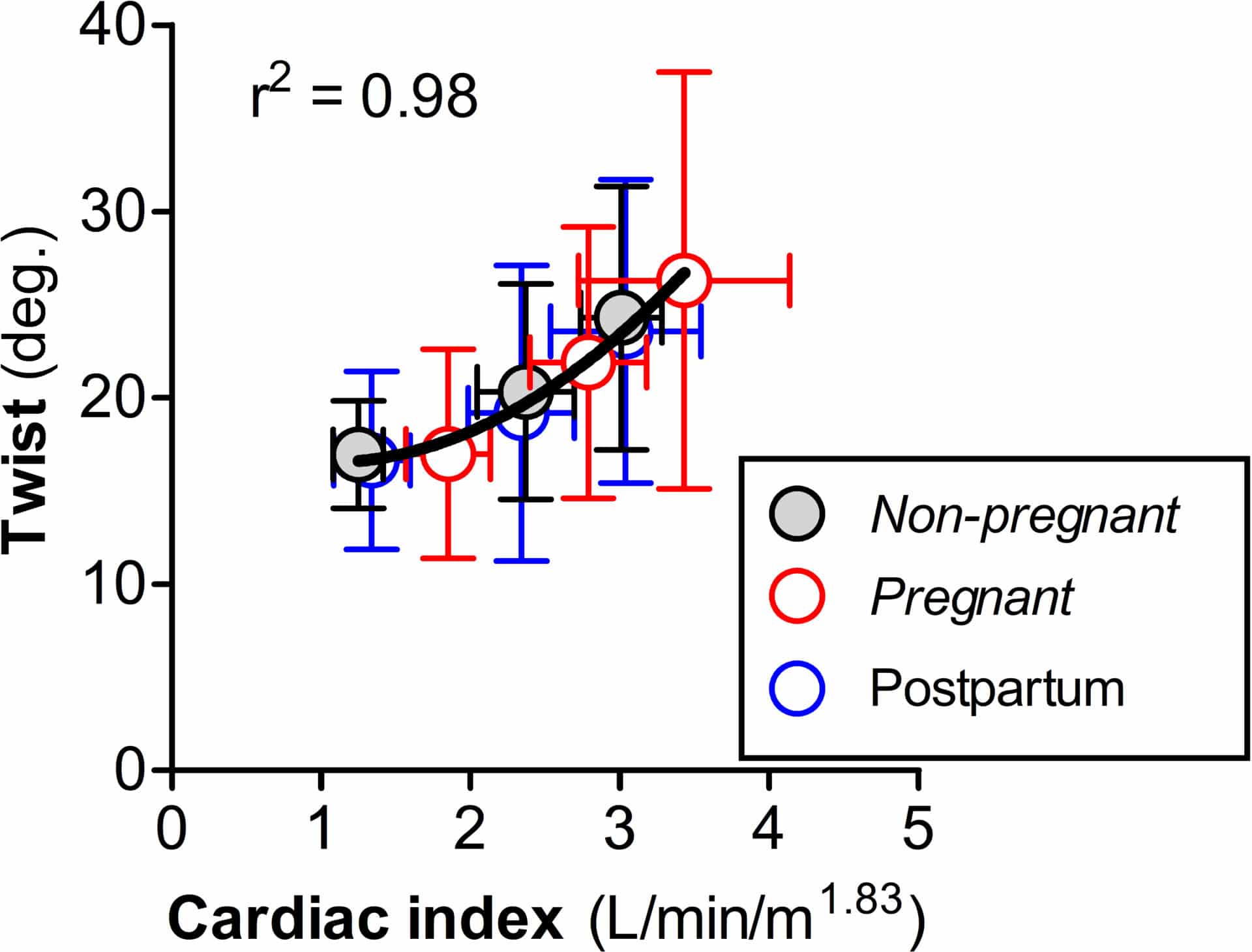Pregnancy results in profound adaptation to maternal cardiovascular demand as reflected by greater left ventricular (LV) size and cardiac output (Q) at rest. However, it is not known whether structural cardiac adaptations alter the LV twist mechanics that underpin normal function, and if the changes in resting structure and function influence the maternal cardiac responses to exercise. The aim of this study was to examine the interplay between structural adaptation and functional responses to submaximal exercise in healthy pregnancy. We hypothesised that pregnant women would have an increased LV twist at rest and, exaggerated cardiac responses to exercise due to the elevated demands of pregnancy. Ethical approval was obtained from Cardiff Metropolitan University Ethics Committee. Healthy non-pregnant women (n=18), pregnant women (n=14, 22-26 weeks of singleton pregnancy) and postpartum women (n=13, 12-16 weeks after birth) provided informed consent to participate in the study. Women underwent standardised assessments of global cardiovascular function (including Q [allometrically scaled], LV mass and end-systolic wall stress [ESWS]) and LV twist (speckle tracking echocardiography) at rest and during cycling exercise at 25 and 50% peak power output. Significant differences (P<0.05) were determined for between-subjects (group), within-subjects (exercise) and group*exercise interaction using a general linear model. The relationship between Q and LV twist at rest and during exercise was identified using a second order polynomial equation of the mean group data per condition. At rest, pregnant women had significantly larger Q (data presented as mean±SD; non-pregnant: 1.2±0.2, postpartum: 1.3±0.3, pregnant: 1.9±0.3 L.min-1/m1.83, P=0.01) but similar LV mass (non-pregnant: 33±6, postpartum: 33±6, pregnant: 35±5 g/m2.7, P=0.56), ESWS (non-pregnant: 73±14, postpartum: 75±14, pregnant: 67±15 kilodynes.cm2, P=0.23) and LV twist (non-pregnant: 13.5±4.0, postpartum: 15.6±4.6, pregnant: 16.5±6.0°, P=0.21) compared to non-pregnant and postpartum women. In contrast to our hypothesis, pregnant women did not have exaggerated cardiac responses to cycling exercise at 25 and 50% peak power output (LV twist: pregnant: 22±7 and 25±12, non-pregnant: 20±6 and 24±7, postpartum: 19±8 and 24±8°, P=0.50; Q: pregnant: 2.8±0.4 and 3.4±0.7, non-pregnant: 2.4±0.3 and 3.0±0.3, postpartum: 2.3±0.4 and 3.0±0.5 L.min-1/m1.83, P=0.96, see Figure 1). These data support that healthy pregnancy-induced structural remodelling does not result in increased cardiac stress, as evidenced by no differences in ESWS or LV twist (a parameter related to intra-myocardial stress distribution). Additionally, despite higher Q at rest, the cardiac output response to exercise during healthy pregnancy is proportionate to the level of exertion, similar to non-pregnant women. These findings support that submaximal exercise does not place undue stress on a healthy pregnant woman’s heart.
Physiology 2019 (Aberdeen, UK) (2019) Proc Physiol Soc 43, PC107
Poster Communications: Healthy pregnancy does not exaggerate the cardiac response to submaximal exercise
V. L. Meah2,1, R. E. Shave2,3, K. Backx2, J. R. Cockcroft4, E. J. Stöhr2,4
1. Faculty of Kinesiology, Sport and Recreation, University of Alberta, Edmonton, Alberta, Canada. 2. School of Sport and Health Sciences, Cardiff Metropolitan University, Cardiff, United Kingdom. 3. Health and Exercise Sciences, University of British Columbia, Kelowna, British Columbia, Canada. 4. Department of Medicine, Division of Cardiology, Columbia University Irving Medical Center, New York, New York, United States.
View other abstracts by:
Figure 1. At rest and during submaximal exercise, cardiac output (allometrically scaled to height) was consistently higher in pregnant women compared to non-pregnant and postpartum women, but the relationship with left ventricular twist (a parameter related to intra-myocardial stress distribution) was maintained across all groups.
Where applicable, experiments conform with Society ethical requirements.

